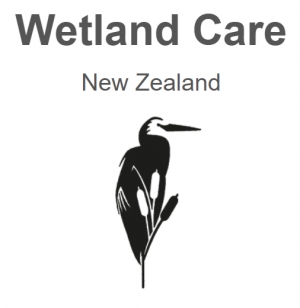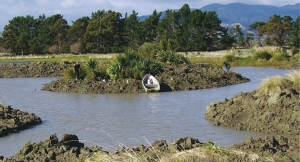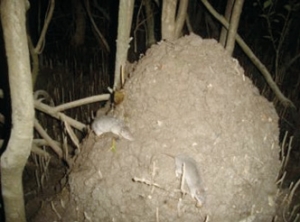Displaying items by tag: WetlandCare
DUNZ Scholarship awarded
The first Ducks Unlimited scholarship has been awarded to Shannon Bentley who is studying for a master’s degree at Victoria University of Wellington. Shannon’s research will include field work at the Wairio wetland.
She is originally from the Wairarapa.
DU is planning a small presentation at the university to award the scholarship to Shannon in March 2020.
Wetland Care Scholarship
Interested in studying wetland birds or wetland restoration? – the Wetland Care Scholarship could be for you!
Background/purpose
Wetland Care Research Scholarships are Ducks Unlimited-sponsored scholarships applicable to any student currently enrolled or affiliated with a New Zealand university.
Funds are aimed at encouraging and supporting students who wish to push the boundaries of what is known about wetland restoration and conservation and whose projects are designed to facilitate better management of New Zealand wetlands or their environment.
Up to $20,000 is available each year to cover one to four separate scholarships of $5000 each. Funds can be used to support student living costs or to cover the costs of equipment purchase, logistics and consumables.
Criteria
Applications will be accepted from students/researchers affiliated with universities interested in making a difference through wetland conservation.
The student project must be based in New Zealand. Preference will be given to applications that demonstrate:
■ projects of direct benefit to New Zealand based on current wetland conservation issues.
■ innovative thinking that pushes the boundaries of what is known about New Zealand wetland conservation.
■ research on native threatened wetland bird species.
■ research with clear objectives and measurable outcomes.
■ research with a strong wetland management and conservation applications.
■ research covering any ‘preferred research topics’ listed on the Ducks Unlimited/Wetland Care website.
Value
Wetland Care will award up to four scholarships a year, in two funding rounds each year for the next three years. The current round, consisting of one or two $5000 scholarships, is being advertised now for 2020.
The next funding round, consisting of another one or two $5000 scholarships, will be advertised early next year. Funds will be paid in one lump sum to successful candidates upon completion of the milestones agreed at the time the scholarship is accepted.
Interested? Or want to know more?
Please email us at This email address is being protected from spambots. You need JavaScript enabled to view it. with your questions or to request an application pack.
Terms and conditions and an application form are available on the Ducks Unlimited website: www.ducks.org.nz/wetland-care/scholarships.
Applications for the current round close on 1 November 2019.
AGM Conference and reports
This year’s Ducks Unlimited New Zealand’s 45th conference was held at the Collegiate Motor Inn in Whanganui, with just over 50 attendees. The weather was kind and, after a bitterly cold, wet and windy Friday, turned on the sunshine in time for the field trip on Saturday, 3 August.
President Ross Cottle opened proceedings at the AGM by saying it had been a reasonably quiet year, with only three members’ wetlands being developed, however work at Wairio Wetland was going well and good progress had been made.
He paid tribute to long-time DU supporter and Wairarapa Chapter Secretary/Treasurer Joyce Brooks who passed away shortly after the previous AGM.
Treasurer John Bishop, after his traditional warm-up joke, presented his report. He confirmed and reviewed the requirements of being a charitable trust, which include providing a mission statement, entity structure and a yearly report of income, expenditure, activities and volunteer support.
The information for the Charities Register notes DU is reliant on volunteers, with about 8000 volunteer hours a year spent on wetlands assessment and building, swan collection, and advice, education, field days, bittern project, supplying magazine content, Wairio planting and education, supporting schools, fundraising, auctions and dinners.
After running through the financials, which show a slight deficit for the year, John concluded:
“We are remain solvent, through support from membership subscriptions, auctions, grants from the Wetland Care Trust, and donations from Treadwells, Pharazyn Trust, Muter Trust, South Wairarapa Rotary and one-off grants.”
Election of Officers
The DU Board remained unchanged, with the two directors whose two-year terms were up, Jim Law and John Dermer, being re-elected unanimously.
Waterfowl and Wetland Trust
David Smith reported that the trust was in good shape thanks to the sharemarket, and despite paying out $40,000 to DU, was in a similar financial position as it was at the end of 2017.
He said the trust was doing exactly what it was set up to do: provide money to enable DU to carry on its work.
Wetland Care
Will Abel said that in line with the previous couple of years, there had been few applications for new projects, with most of the wetland creation activities centred on the Wairio Wetland.
A large wetland in Pahiatua that DU committed $5000 to three years ago had been completed, and in Masterton, DU had helped created another large wetland, to which it contributed $4000.
Royal Swan
Will Abel said it had been a disastrous year for the royal swan, with no cygnets available and even the wildlife centre at Peacock Springs, Canterbury, the usual source of swans, was looking for some new breeding stock.
“We have no idea why really, but anecdotally I suspect it is because it coincides with the 50th anniversary of the moon landing,” he said, tongue in cheek.
“If it improves next year, my supposition will be proved correct, and I will present a paper at the next conference on it.”
He said it was fortunate that there had not been many requests for swans.
Whio
Peter Russell reported that the breeding programme had had a good season, with 65 whio reared from captive pairs and 15 reared from wild clutches. A total of 72 were released.
In the North Island, 30 were released. Three older birds from last season were released on the Whakapapanui in December, and 12 birds, six males and six females, were released at Blue Duck Station in January.
The third release, on the Manganui a-te-Ao, was in early March, with eight males released at the Ruatiti Domain and four females released down the river where there was a surplus of males. Three male birds were released on Mangawhero stream on 20 March.
Peter said it was always a great thrill to take part in the releases out on the river. He has been doing them since 1997 and it has changed so much. In 2000 they released seven, compared with 72 in the past year.
In the South Island, 20 birds were released on the West Coast in January in the Wainihinihi, Arahura, Styx and Kawhake rivers; 12 birds were released on the Taipo River in March; in Tasman 10 birds were released.
Membership
Paul Mason reported that DU currently had 280 members, with 57 of those unpaid as at the AGM.
He said a second subs reminder would be sent out, following email and postal reminders subsequent to the initial subs mailout.
He noted that in the past three years, payment preferences were moving from cheque to internet banking. Credit card payments remained about the same and PayPal transactions were increasing.
More members were responding to the suggestion that DU communicated with them more by email, he said.
Website
Paul said new articles were added as events occur, with the most recent being the planting day at Wairio Wetland. Flight magazines, from No 155 to the current issue, have been loaded on to the site. Issue 29 has also been scanned and added as a PDF file.
Articles from more recent Flight magazines are being transcribed and loaded as searchable items – so far back to issue 159. Old issues are being scanned and loaded as PDFs.
He noted a drop-off in website visitors in the past three months and in response had upgraded the site-mapping software and re-registered the site with search engines.
The main files being downloaded were Flight magazines and people were also accessing the educational resources files (from Quack Club), he said.
Wairio Wetland
Jim Law reported that the wetland was in good heart, benefiting from continued restoration work, albeit at a more modest cost to DU ($4455 versus $9500 in the prior year). Work focused on more bund wall improvements ($1700), tree planting ($2000) and noxious plant control ($755).
At last, significant progress was made by the Greater Wellington Regional Council to reticulate water from Matthews Lagoon and Boggy Pond to Wairio. Earthworks have been completed but after a “weather event”, remedial work is required. This will be done this summer.
“We had provisionally budgeted to fund a portion of this work but GWRC assumed full responsibility,” he said.
Total expenditure by the Wairio Restoration Committee, not counting volunteer time, since inception 14 years ago, now stands at $220,000.
The Victoria University of Wellington School for Biodiversity and Restoration Ecology remain focused on their research at Stage 3.
The Restoration Committee is still holding funds (lodged with DU) from fundraising efforts totalling $10,807. A further $15,000 grant was recently received by local donors. These funds are also being held by DU on behalf of the project committee.
As mentioned last year, Wairarapa Moana, which includes the Wairio Wetland (administered by DOC on behalf of the Crown), has been included in a Treaty of Waitangi settlement with Wairarapa iwi. “Whilst the settlement has been delayed, the local iwi has assured us that they want us to continue our good work restoring the Wairio Wetland.
“We remain of the view, though perhaps slightly biased, that DU members should be proud of this project,” Jim said.
Scholarships
Jim Law reported on DU’s new initiative offering scholarships to students doing research in a relevant area. A trial offering a total of $25,000 over three years in grants of $5000 per student so far had had little response to date.
Four universities had been approached and it was likely the first recipient of one of the $5000 grants would come from Victoria University working on the Wairio site.
Wetland Care
Our business is to harness community, business and government resources to restore and develop lost wetland areas within New Zealand.
environment, acting as huge ecological sponges by soaking up pollutants and filtering water before it reaches streams, rivers, lakes, aquifers and the sea.
Our initiatives focus on matters as far-reaching as groundwater replenishment, flood control, nutrient and contaminant management and climate change – all critical factors for the conservation of freshwater and saltwater wetlands and marshes.
We want to preserve and conserve the flora and fauna of our most endangered ecosystem so that vibrant wetlands are our legacy to future generations.
Central to Wetland Care New Zealand’s mission is forming partnerships with people and organisations with similar aims. Money from our partnership with Banrock Station Wines has been given to wetland conservation projects done by, among others:
- Tutukaka Landcare Coalition
- Tawharanui Open Sanctuary Society Inc.
- Ducks Unlimited Operation Pateke
- Port Charles release 2005 at Coromandel
- Henley Trust, Masterton
- Karori Wildlife Sanctuary, Wellington
- Kitchener Park, Feilding
- Manawatu Estuary Trust, Foxton
- Mangaone Wetland, Raetihi
- Masterton Intermediate School
- Steyning Trust, Hawke’s Bay
- Travis Wetland Trust, Christchurch
- Wairo Wetland, South Wairarapa
- Wetland Trust New Zealand,
- Rangiriri Waitakere Branch Forest and Bird
- Yellow-eyed Penguin Trust, Dunedin
- Cape kidnappers pateke release, 2008 and 2009
- Fiordland pateke release, 2009.
WetlandCare Australia discovery programme for primary schools
WetlandCare Australia launched their Wetland Discovery Programme last March, a curriculum-linked environmental teaching package for primary schools. It’s a practical and hands-on programme already proving to engage students in their local environment.
WetlandCare Australia, with the support of the National Australia Bank, has been working for 18 months to develop the Programme with Ocean Shores Public School as their test case.
“I’ve been amazed at the enthusiasm of students, teachers, parents and the broader community. It really is a programme they can all work together on, that is what makes it unique and effective” said Cassie Price, Regional Manager for WetlandCare Australia.
The Wetland Discovery Programme includes a kit for teachers and students with tailored lessons appropriate for each stage (1-3). The kit contains material that relates directly to a wetland in their local environment. “Even if there isn’t a wetland the students can access readily, most activities can still be undertaken without that element, but it is what makes it most relevant for the students, so it’s a key feature of the Programme” said Simone Haigh, Senior Project Officer for WetlandCare Australia.
WetlandCare Australia has assisted Ocean Shores Public School to get the most out of their Wetland Discovery Programme by installing a walking trail through their local wetland, with learning stations that relate to the Programme activities. Nest boxes with cameras and microscopes that can link back to the class interactive whiteboards have also added to the innovations.
The Wetland Discovery Teacher and Student kits are available as a free download from the WetlandCare Australia website. Those schools that want to take the Wetland Discovery Programme further than just the kit, with a trail, learning stations, nest boxes and more, are encouraged to get in touch with WetlandCare Australia for assistance in sourcing funding for additional resources.
Wetland research grants
Interested in studying wetland birds or wetland restoration? – the Wetland Care scholarship could be for you!
Background/purpose
Criteria
- innovative thinking that pushes the boundaries of what is known about New Zealand wetland conservation
- research on native threatened wetland bird species
- research with clear objectives and measurable outcomes
- research with a strong wetland management and conservation applications
- research covering any ‘preferred research topics’ listed on the Ducks Unlimited/Wetland Care website: www.ducks.org.nz.
Value
How and when to apply
- Applications for the September 2018 funding round will open until November 1, 2018. Depending upon the quality of applications, we may award up to two $5000 scholarships.
- The next applications will be called for in February 2019. This round will consists of up to two more $5000 scholarships.
Want to know more?
A hand at Hexam Swamp
Two of CVA’s Better Earth teams started work in August to plant 8000 trees at Hexham Swamp. The trees will reinstate Coastal Foothills Spotted Gum – Ironbark Forest in open paddocks at Hunter Water’s Shortland Waste Water Treatment Works. The outcome will be a more biodiverse habitat for wildlife, improved carbon storage to mitigate global warming, and a buffer to reduce urban nutrients entering the Swamp.
The Swamp adjoins Hunter Wetlands Centre and flows into the Hunter Estuary Wetlands Ramsar Site. It is listed in the Directory of Important Wetlands of Australia, and is part of the Hunter Estuary Important Bird Area.
WCA Hunter’s Senior Project Officer Tim Mouton said, “Thanks to Paul Davidson and his trusty tractor, the preparation on the site proceeded well and we were ready to start. The site had been slashed, sprayed and deep ripped, so planting was forward.”
Wild cattle were found on site, so a temporary electric fence was installed to make sure the precious plants are not trampled or disturbed. WetlandCare Australia working with Local Land Service’s will have the cattle removed.
Joining the dots on Watermouse
With support of several organisations, Janina Kaluza has been surveying, monitoring and researching the water mouse in a number of locations throughout the Wide Bay and South East Queensland region since February 2012. This work has expanded and built on previous research in the past 15 to 20 years by scientists within State Government and the broader community. However, gaps remain on information that Janina aims to fill.
The water mouse inhabits coastal areas of central and south east Queensland, Northern Territory and New Guinea, and is typically found in coastal saltmarsh and mangrove areas. A key sign of their presence is their nesting mounds that range from free-standing mounds in saltwater couch grasslands to sheltered mounds in sites such as the base of old grey mangrove trees (Avicennia marina) located within the intertidal zone. The water mouse forages in the mangroves at night, feasting on invertebrates such as crabs, shellfish and snails. Loss, fragmentation and degradation of their habitats are key threats to their survival.
Working with local councils, WetlandCare Australia has been awarded funding to undertake a number of small local projects to survey potential water mice habitat areas. The combined information from these projects will contribute towards completing the jigsaw puzzle on water mice in south east Queensland.
Another project focuses on surveying key habitat areas on Russell Island, one of the Southern Moreton Bay Islands, with funding support from a Redland City Council’s Conservation Grant. The water mouse was recorded on the island in the 1990s. The project aims to determine if the water mouse is still present and identify current threats to its habitat and survival. Surveys undertaken over three days in May this year and the data and survey results are currently being collated.
Funding through the City of Gold Coast’s Community Grants Program, WetlandCare Australia will be focussing water mouse survey effort in the Jacobs Well area in early 2016. Survey work will build on knowledge obtained in the 1990s that recorded the presence of the water mouse in this area. Logan City Council, through their Enviro Grants allows for surveying potential habitat areas on the Logan River in search of the water mouse. Approximately 40ha of mangrove areas will be surveyed in early 2016 to record the presence or absence of nests.
Water mice surveys will also be undertaken in early 2016 over 80ha of mangrove vegetation near the mouth of the Caboolture River with funding through the Moreton Bay Regional Council’s Community Grants Program. This project aims to identify the presence or absence of the water mouse in this area. The water mouse has been recorded previously at nearby Donnybrook.





